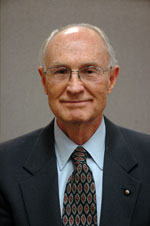From the Editor Emeritus / John F. Fink
Year of Faith: The rosary, the perfect prayer
 October is traditionally observed as the Month of the Rosary.
October is traditionally observed as the Month of the Rosary.
The rosary has been called the perfect prayer because it combines prayer, meditation and Scripture. The repetition of prayers is meant to create an atmosphere in which to meditate on the mysteries of our salvation as revealed in Scripture.
The main focus is on the birth, life, death and resurrection of Jesus. These are the “mysteries” or events that the pray-er thinks about while praying the rosary.
The rosary consists of a string of beads divided into five sets known as decades because they have 10 beads in each set. Sometimes those praying the rosary will add a few additional prayers, but five Our Fathers and 50 Hail Marys basically make up the rosary.
The rosary was begun in the late 12th century when laity began to pray 150 Hail Marys in imitation of the 150 psalms. St. Dominic and his followers popularized it in the 13th century, adding the meditations about the life of Jesus.
In the early 15th century, the Carthusian monk Dominic of Prussia divided the 150 Hail Marys into three sets of 50. He also began to call each of the 50 points of meditation a rosarium (rose garden) because the rose was a symbol of joy and Mary was “the cause of our joy” for bearing Christ. Thus the name “rosary” became the name for the devotion.
Another 15th-century Carthusian monk, Henry of Kalkar, then divided the 50 Hail Marys into decades with an Our Father between each.
In 1483, a Dominican priest wrote a book on the rosary called Our Dear Lady’s Psalter. It listed the same 15 mysteries that we meditated about through the 20th century except that the fourth glorious mystery combined Mary’s assumption and coronation and the fifth glorious mystery was the Last Judgment.
For more than 500 years, there were 15 official mysteries: five joyful, which concern the beginning of our redemption (the Annunciation, the Visitation, the Nativity, the presentation in the Temple, and finding the child Jesus in the Temple); five sorrowful, which pertain to Christ’s passion (the agony in the garden, the scourging, the crowning with thorns, the carrying of the cross, and the Crucifixion); and five glorious (the Resurrection, the Ascension, the descent of the Holy Spirit, the Assumption and the Coronation of Mary).
There was an obvious gap between the finding of Jesus in the Temple when he was 12 and his Passion and death. Therefore, in 2002, Pope John Paul II added the five luminous mysteries, or mysteries of light, recalling events in Jesus’ public ministry—his baptism, the wedding feast at Cana, the proclamation of the Kingdom of God, the Transfiguration, and the institution of the Eucharist.
With those additions, the rosary really is what Pope Paul VI called it in his 1974 apostolic exhortation “Marialis Cultus:” “a compendium of the entire Gospel.”
Some people pray what is called the Scriptural Rosary. It includes a Scripture text before each Hail Mary.
The rosary has been an important part of Catholicism for about eight centuries. †
 October is traditionally observed as the Month of the Rosary.
October is traditionally observed as the Month of the Rosary.